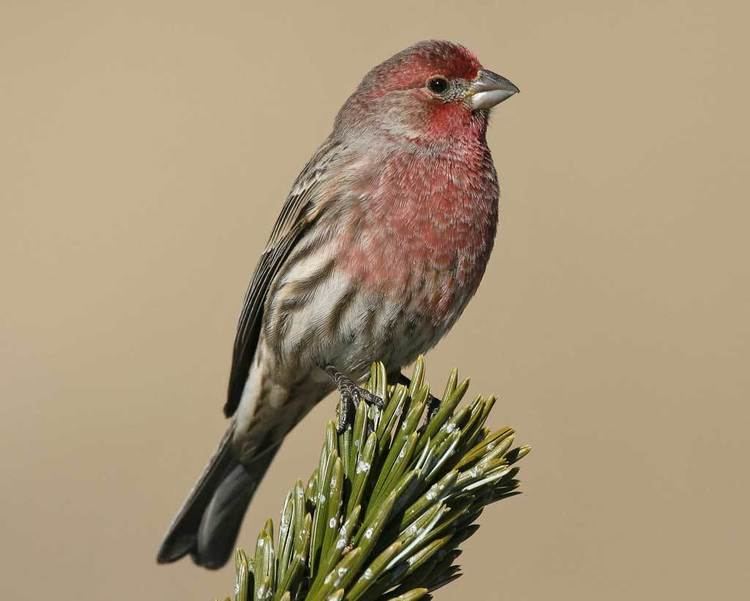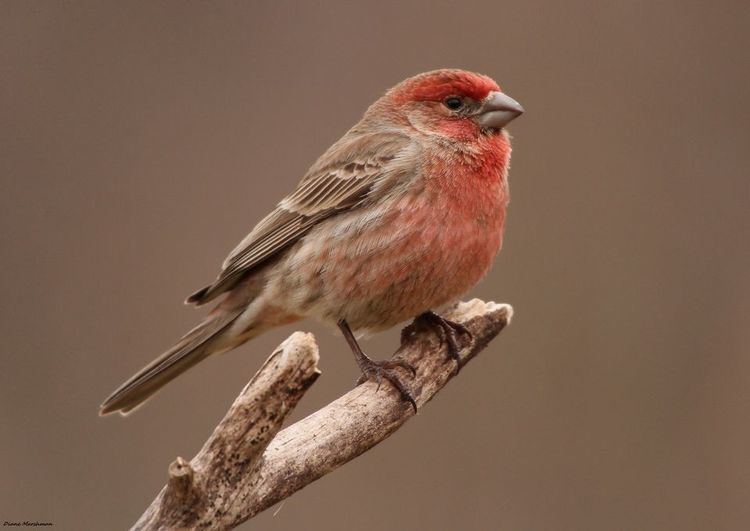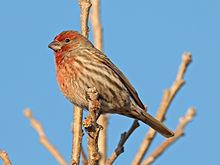Order Passeriformes Scientific name Haemorhous mexicanus Higher classification Rosefinch | Phylum Chordata Family Fringillidae Genus Haemorhous Rank Species | |
 | ||
Similar Bird, Finch, Purple finch, Rosefinch, American Goldfinch | ||
Red house finch song bird singing
The house finch (Haemorhous mexicanus) is a bird in the finch family Fringillidae. It is native to western North America, and has been introduced to the eastern half of the continent and Hawaii. This species and the other "American rosefinches" are placed in the genus Haemorhous.
Contents
- Red house finch song bird singing
- Backyard bird watching house finch nest 5 weeks complete documentary
- Description
- Taxonomy
- Range and habitat
- Feeding
- Breeding
- Parasites
- References

Backyard bird watching house finch nest 5 weeks complete documentary
Description

This is a moderately-sized finch. Adult birds are 12.5 to 15 cm (4.9 to 5.9 in) and span 20 to 25 cm (7.9 to 9.8 in). Body mass can vary from 16 to 27 g (0.56 to 0.95 oz), with an average weight of 21 g (0.74 oz). Among standard measurements, the wing chord is 7 to 8.4 cm (2.8 to 3.3 in), the tail is 5.7 to 6.5 cm (2.2 to 2.6 in), the culmen is 0.9 to 1.1 cm (0.35 to 0.43 in) and the tarsus is 1.6 to 1.8 cm (0.63 to 0.71 in). Adults have a long, square-tipped brown tail and are a brown or dull-brown color across the back with some shading into deep gray on the wing feathers. Breast and belly feathers may be streaked; the flanks usually are. In most cases, adult males' heads, necks and shoulders are reddish. This color sometimes extends to the belly and down the back, between the wings. Male coloration varies in intensity with the seasons and is derived from the berries and fruits in its diet. As a result, the colors range from pale straw-yellow through bright orange (both rare) to deep, intense red. Adult females have brown upperparts and streaked underparts.
Their song is a rapid, cheery warble or a variety of chirps.
Taxonomy

This bird belongs to the genus Haemorhous, together with the purple finch and Cassin's finch. These three species are not closely related to the Old World Carpodacus rosefinches.
Range and habitat

These birds are mainly permanent residents throughout their range; some northern and eastern birds migrate south. Their breeding habitat is urban and suburban areas across North America, as well as various semi-open areas in the west from southern Canada to the Mexican state of Oaxaca; the population in central Chiapas may be descended from escaped cagebirds.

Originally only a resident of Mexico and the southwestern United States, they were introduced to eastern North America in the 1940s. The birds were sold illegally in New York City as "Hollywood Finches", a marketing artifice. To avoid prosecution under the Migratory Bird Treaty Act of 1918, vendors and owners released the birds. They have since become naturalized; in largely unforested land across the eastern U.S., they have displaced the native purple finch and even the non-native house sparrow. In 1870, or before, they were introduced to Hawaii and are now abundant on all its major islands.
There are estimated to be anywhere from 267 million to 1.7 billion individuals across North America.
Feeding
House finches forage on the ground or in vegetation normally. They primarily eat grains, seeds and berries, being voracious consumers of weed seeds such as nettle and dandelion; included are incidental small insects such as aphids. They are frequent visitors to bird feeders throughout the year, particularly if stocked with sunflower or nyjer seed, and will congregate at hanging nyjer sock feeders. The house finch is known to damage orchard fruit and consume commercially grown grain but is generally not considered a significant pest but rather an annoyance.
Breeding
Nests are made in cavities, including openings in buildings, hanging plants, and other cup-shaped outdoor decorations. Sometimes nests abandoned by other birds are used. Nests may be re-used for subsequent broods or in following years. The nest is built by the female, sometimes in as little as two days. It is well made of twigs and debris, forming a cup shape, usually 1.8 to 2.7 m (5.9 to 8.9 ft) above the ground.
During courtship, the male will touch bills with the female. He may then present the female with choice bits of food, and if she mimics the behavior of a hungry chick, he may actually feed her. The male also feeds the female during the breeding and incubation of both eggs and young, and the male is the primary feeder of the fledgelings (who can be differentiated from the females by the pin feathers remaining on their heads). Females are typically attracted to the males with the deepest pigment of red to their head, more so than the occasional orange or yellowish-headed males that sometimes occur.
The female lays clutches of eggs from February through August, two or more broods per year with 2 to 6 eggs per brood, most commonly 4 or 5. The egg laying usually takes place in the morning, at the rate of one egg per day. The eggs are a pale bluish green with few black spots and a smooth, somewhat glossy surface. In response to mite infestation, which has a more deleterious effect on male chicks than on females, the mother finch may lay eggs containing females first, in order to reduce the length of time male chicks are exposed to mites. This strategy increases the liklihood that representative numbers of both sexes will survive. The female incubates the eggs for 12 to 14 days. Shortly after hatching, she removes the empty eggshells from the nest. The hatchlings are pink with closed eyes and tufts of fluffy down. The female always feeds the young, and the male usually joins in. The young are silent for the first seven or eight days, and subsequently start peeping during feedings. Initially, the mother carries fecal sacs out of the nest, but when the young become older, she no longer carries them all away, allowing droppings to accumulate around the edge of the nest. Before flying, the young often climb into adjacent plants, and usually fledge at about 11 to 19 days after hatching. Dandelion seeds are among the preferred seeds fed to the young. Most birds, even ones with herbivorous leanings as adults, tend to feed their nestlings animal matter in order to give them the protein necessary to grow. House finches are one of the few birds who feed their young only plant matter.
House finches are aggressive enough to drive other birds away from places such as feeders.
Parasites
The house finch may be infected by a number of parasites including Plasmodium relictum and Mycoplasma gallisepticum, which caused the population of house finches in eastern North America to crash during the 1990s.
The mite Pellonyssus reedi is often found on house finch nestlings, particularly for nests later in the season.
The brown-headed cowbird, a brood parasite, will lay its eggs in house finch nests, although the diet house finches feed their young is inadequate for the young cowbirds, which rarely survive.
